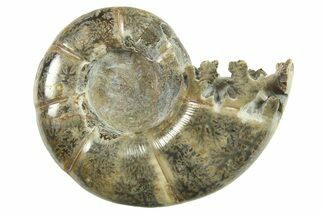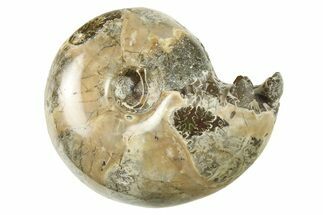3.3" Polished Ammonite (Phylloceras) Fossil - Madagascar
This is a beautiful 3.3" wide polished ammonite (Phylloceras sp.) fossil from the Mahajanga Province of Madagascar. It is Early Cretaceous (Albian Stage) in age, or approximately 110 million years old. The sutures on it have been meticulously exposed and cleaned making the ammonite look that much nicer.
Comes with an acrylic display stand.
Comes with an acrylic display stand.
About Ammonites
Ammonites were predatory, marine mollusks that thrived during the Paleozoic and Mesozoic eras, particularly in the Jurassic and Cretaceous periods, before going extinct around 66 million years ago. These creatures are characterized by their coiled, spiral shells, which resemble the modern-day nautilus. Ammonite shells were divided into chambers; as they grew, they built new chambers and sealed off the old ones. These chambers were filled with gas, which helped them control buoyancy in the ocean.
The outer shell of ammonites often displays intricate ribbed or ridged patterns and their fossils sometimes show a wide range of beautiful colors due to mineralization over time. The shells fossilized well, making ammonites abundant in the fossil record.. In addition to being popular in fossil collections, ammonites are valuable in geological studies, as they serve as index fossils, helping scientists date rock layers and understand the Earth's prehistoric environments.
Ammonites were predatory, marine mollusks that thrived during the Paleozoic and Mesozoic eras, particularly in the Jurassic and Cretaceous periods, before going extinct around 66 million years ago. These creatures are characterized by their coiled, spiral shells, which resemble the modern-day nautilus. Ammonite shells were divided into chambers; as they grew, they built new chambers and sealed off the old ones. These chambers were filled with gas, which helped them control buoyancy in the ocean.
The outer shell of ammonites often displays intricate ribbed or ridged patterns and their fossils sometimes show a wide range of beautiful colors due to mineralization over time. The shells fossilized well, making ammonites abundant in the fossil record.. In addition to being popular in fossil collections, ammonites are valuable in geological studies, as they serve as index fossils, helping scientists date rock layers and understand the Earth's prehistoric environments.
SPECIES
Phylloceras sp.
LOCATION
Ambatolafia, Mahajanga Province, Madagascar
SIZE
3.3" wide
CATEGORY
SUB CATEGORY
ITEM
#283501
We guarantee the authenticity of all of our specimens.
 Reviews
Reviews












